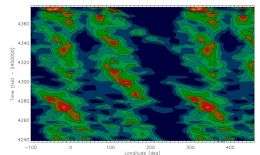Young active star resembles the young Sun

(PhysOrg.com) -- The CoRoT satellite, a space mission led by the French Space Agency CNES with the participation of Austria, Belgium, Brazil, Germany, Spain and the European Space Agency, ESA (RSSD and Science programme, that includes an Italian contribution), has recently observed a star analogous to the young Sun at an age of approximately 500 million years, named CoRoTExo-2a.
This star is accompanied by a giant planet orbiting around it in only 1.7 days, that was discovered by the CoRoT Extrasolar Planet Team. An investigation on the intrinsic variations of the star has been carried out by another international team, led by astronomers of the Italian National Institute for Astrophysics (INAF) at Catania Astrophysical Observatory with the support of the Italian Space Agency (ASI). It will be published on Tuesday, Dec. 23, 2008 on Astronomy & Astrophysics.
With its very high photometric accuracy and the long duration of continuous observations, CoRoT has been able for the first time to measure the variations of the intensity of the star and follow it for more than 150 days.
These unique data show flux variations of about 6 percent, at least 20 times greater than those of the present Sun, with a periodic modulation of 4.5 days. They are produced by spots, analogous to sunspots, but having a correspondingly larger area, that evolve continuously as the star rotates.
CoRoT observations revealed an unexpected phenomenon: the spotted area oscillates with a mini-cycle of only 29 days. In the Sun, such mini-cycles have sometimes been observed close to the maxima of the main 11-year cycle, with a period of about 150 days. They have been accompanied by corresponding modulations in the frequency and intensity of solar flares, whose energetic radiation impacted upon the planets. The shorter period observed in CoRoT-Exo-2a may be due to its faster rotation or the perturbations induced by the close giant planet, orbiting at a distance of only 4.2 million kilometers from the star, i.e., only 3 percent the distance between the Sun and the Earth.
Our Sun, during the evolutionary stage corresponding to that of CoRoT-Exo-2a, was shining on the Earth when the processes that would have led to the appearance of life had just begun. The presence of an intense magnetic activity on the young Sun and its light variability certainly affected those processes.
The study of Sun-like stars with the CoRoT satellite and other spaceborne or ground-based telescopes will contribute to our understanding of the influence of stars on their planets during those crucial phases of their evolution. In the specific case of CoRoTExo-2a, additionally interesting results are expected from future observations, also with ground-based telescopes, to confirm the possible effect of the giant planet on stellar magnetic activity.
Paper: "Magnetic activity in the photosphere of CoRoT-Exo-2a. Active longitudes and short-term spot cycle in a young Sun-like star", by A. F. Lanza et al. Astronomy & Astrophysics. www.aanda.org/doi/10.1051/0004-6361:200810591/pdf
Provided by Astronomy & Astrophysics




















